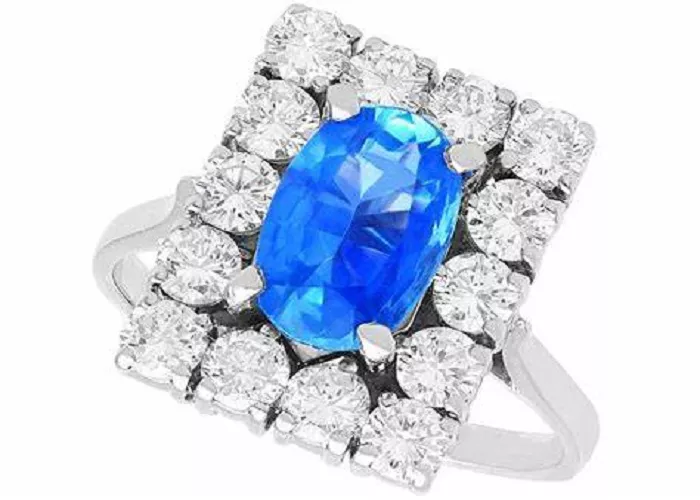Sapphires are among the most prized gemstones in the world. A 3-carat sapphire is a stunning choice for engagement rings, earrings, and necklaces. This guide will cover everything you need to know about 3-carat sapphires, including their color, quality, price, and how to choose the best one.
What Is a Sapphire?
Sapphires are a variety of the mineral corundum. They are known for their rich blue color, but they come in many other shades, including pink, yellow, green, and even colorless.
Sapphires rank 9 on the Mohs hardness scale, making them very durable for everyday wear. They are a classic choice for engagement rings, second only to diamonds.
A 3-carat sapphire is large enough to make a bold statement while still being practical for jewelry.
Why Choose a 3-Carat Sapphire?
A 3-carat sapphire is a perfect balance between size and wearability.
It is big enough to stand out but not too heavy or bulky. It works well in rings, pendants, and earrings. High-quality 3-carat sapphires hold their value well over time.
Colors of 3-Carat Sapphires
Sapphires come in many colors, but the most famous is blue.
Blue Sapphires
The most popular shade ranges from light to deep royal blue. Cornflower blue is a bright, medium blue similar to the Kashmir sapphire. Teal blue offers a mix of blue and green, giving a unique ocean-like hue.
Fancy Color Sapphires
Pink sapphires range from soft pink to vivid hot pink. Yellow sapphires come in sunny yellow to golden tones. Padparadscha is a rare pink-orange sapphire that is highly valuable. Green and purple sapphires are less common but beautiful in jewelry.
The color of a sapphire greatly affects its price and rarity.
Quality Factors of a 3-Carat Sapphire
Several key factors determine a sapphire’s quality.
Color
The hue is the primary color, such as blue, pink, or yellow. Saturation refers to how intense the color is, while tone describes the lightness or darkness of the color. The best choice is a rich, even color with no dullness.
Clarity
Sapphires often have small inclusions, which are natural flaws. Eye-clean sapphires with no visible flaws are the most valuable. Some inclusions, like silk, can enhance beauty, as seen in Kashmir sapphires.
Cut
A good cut enhances the sapphire’s sparkle and color. Common cuts include oval, round, cushion, emerald, and pear. Poor cuts can make the stone look dull or uneven.
Carat Weight
A 3-carat sapphire weighs about 600 mg, roughly the size of a small grape. Larger sapphires are rarer, so the price increases with size.
Where Do 3-Carat Sapphires Come From?
The origin of a sapphire affects its value.
Major Sapphire Sources
Kashmir in India is famous for velvety blue sapphires, though they are very rare. Burma, now Myanmar, produces high-quality deep blue sapphires. Sri Lanka, formerly Ceylon, is known for bright blue and fancy-colored sapphires. Madagascar offers beautiful blue and teal sapphires, while Australia and Thailand produce more affordable but often darker stones.
Kashmir and Burmese sapphires are the most expensive due to their exceptional quality.
Natural vs. Lab-Created 3-Carat Sapphires
Natural Sapphires
Natural sapphires are formed over millions of years in the earth. They are more valuable and unique, often containing natural inclusions.
Lab-Created Sapphires
Lab-created sapphires have the same chemical composition as natural ones but are made in a lab. They are much cheaper, often 70-90% less expensive, and usually flawless. They are also an eco-friendly option.
The choice between natural and lab-created depends on budget and preference. Natural sapphires are ideal for collectors, while lab-created sapphires offer affordability without sacrificing beauty.
Price of a 3-Carat Sapphire
Prices vary widely based on quality.
Low-quality sapphires with pale color and visible inclusions range from 2,400 for a 3-carat stone. Medium-quality sapphires with good color and few flaws cost between 9,000. High-quality vivid, eye-clean sapphires can range from 45,000 or more.
Top-quality Kashmir or Burmese sapphires can exceed $60,000 for 3 carats. Fancy colors like Padparadscha can be even more expensive due to their rarity.
Best Jewelry for a 3-Carat Sapphire
Engagement Rings
A 3-carat sapphire makes a stunning centerpiece for an engagement ring. Popular settings include halo, solitaire, or three-stone designs.
Earrings
A pair of 3-carat sapphires creates luxurious studs or drop earrings.
Pendants and Necklaces
A single 3-carat sapphire pendant offers an elegant and timeless look.
Men’s Jewelry
Bold sapphire rings or cufflinks provide a sophisticated option for men’s jewelry.
How to Buy a 3-Carat Sapphire
Choose a Reputable Seller
Look for certified gemstones with reports from GIA, AGL, or SSEF. Avoid deals that seem too good to be true.
Check the Quality Factors
Prioritize color and clarity first. Ensure the cut maximizes brilliance and the carat weight meets your preferences.
Compare Natural and Lab-Created
Decide whether you prefer an investment-worthy natural stone or a budget-friendly lab-created option.
Ask About Treatments
Heat treatment is common and acceptable, but avoid heavily treated or dyed sapphires.
View in Different Lighting
Sapphires can look different in natural versus artificial light, so examine them in various settings.
Caring for a 3-Carat Sapphire
Clean your sapphire with warm soapy water and a soft brush. Store it in a separate pouch to avoid scratches. Remove the jewelry when using harsh chemicals or cleaning products. Have a jeweler inspect the prongs and settings yearly to ensure the stone remains secure.
Conclusion
A 3-carat sapphire is a luxurious and meaningful gemstone. Whether you prefer a deep blue, a rare Padparadscha, or a lab-created option, understanding color, clarity, and origin will help you choose the best stone. With proper care, a 3-carat sapphire can last a lifetime and become a cherished heirloom.
Related Topics:
The Allure of the Heart-Shaped Sapphire Ring: A Complete Guide
What Does a Real Sapphire Look Like?


